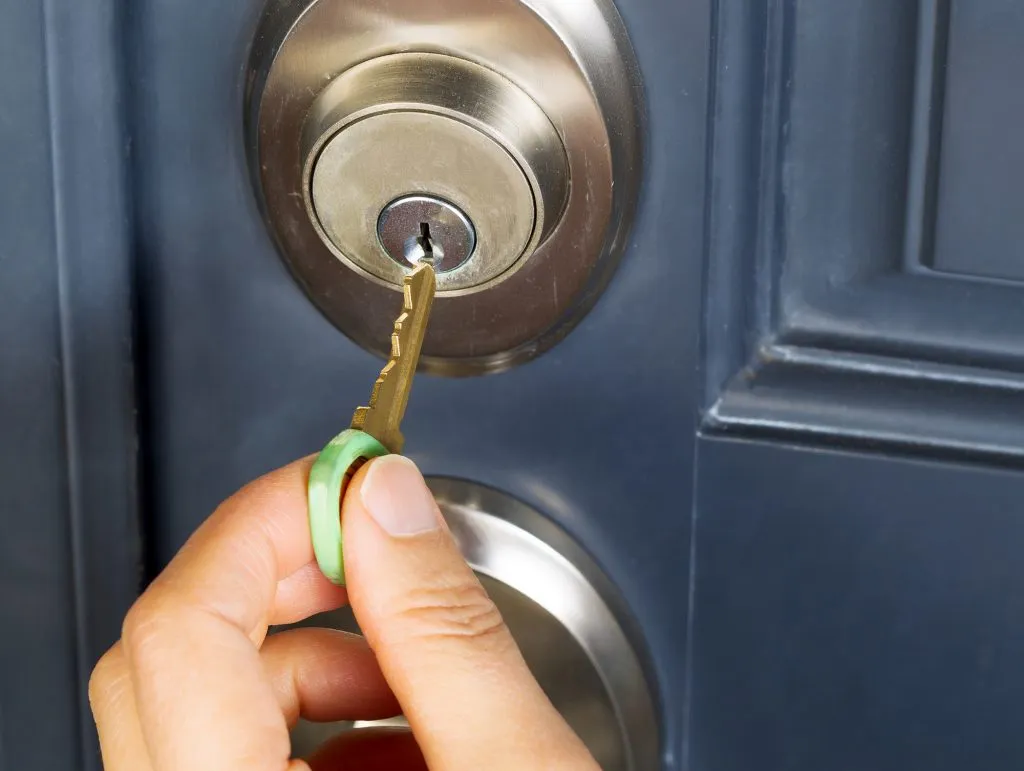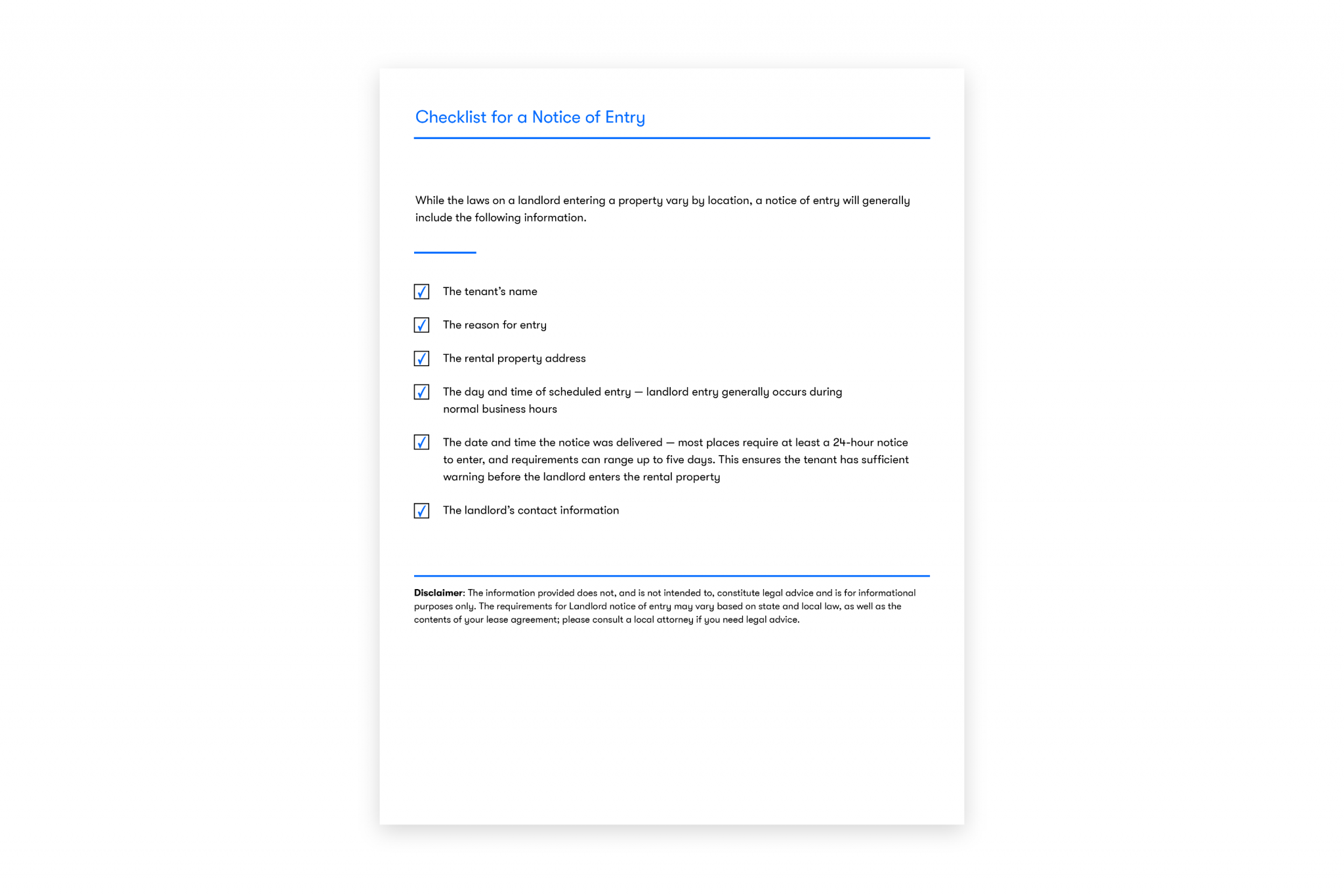Notice of Entry From a Landlord to a Tenant

December 13, 2019
7 min read
In this article:
- Why might a landlord need to enter a property?
- Does a landlord need to give notice before visiting?
- What should be included in a notice of entry?
- How much notice must a landlord give before entering?
- What is a reasonable time of entry?
- Can a landlord enter without permission?
- Can a landlord enter a property during an eviction?
- Can a tenant refuse entry to a landlord?
- When can landlords enter without notice?
- What happens if the tenant has abandoned the property?
Maintaining a rental property is an ongoing job, and there will be times when a landlord needs to access a tenant's apartment or house. However for a landlord to enter a property, there may be rules like providing notice of entry to respect the tenant's right to privacy.
Note: This guide is for informational purposes only. Zillow, Inc. does not make any representations or warranties about the sufficiency of the information in or linked to from this guide, or that it’s consistent or compliant with applicable laws, statutes, regulations or common law. Landlord-tenant laws change rapidly and may be regulated at the federal, state or local levels. This resource is not a substitute for the advice or service of an attorney; you should not rely on this resource for any purpose without consulting with a licensed attorney in your jurisdiction.
Why might a landlord need to enter a property?
A landlord may need to access the property for many different reasons, including:
- Emergency repairs such as a plumbing leak or broken furnace
- Regular maintenance like replacing lightbulbs or smoke detector batteries
- Home improvement projects
- Landscaping
According to the Zillow Group Consumer Housing Trends Report 2019, among the 69% of homeowners who did some improvement in the past year, the most common for all homeowners were: landscaping (28%), new appliances (26%) and painting the interior (24%). Whether you're doing routine maintenance, renovations or emergency repairs, it's always best to provide notice to your tenant.
Does a landlord need to give notice before visiting?
Before entering a tenant's apartment, the landlord should consider whether entry is allowed under the tenant’s lease and under local landlord-tenant laws. A landlord may be required to provide notice of entry, sometimes called a notice to enter, to the tenant before entering the property. Typically, a notice of entry is given to the tenant in the form of a letter, which informs the tenant of the landlord's intent to enter the property on a given date and time.
What should be included in a notice of entry?
While the laws on a landlord entering property vary by location, a notice of entry will generally include the following information:
- The tenant's name
- The reason for entry
- The rental property address
- The day and time of scheduled entry
- The landlord's contact information
You can download a checklist of all the items that must be included in a notice of entry form by clicking on the green Download button at the top of this page.

How much notice must a landlord give before entering?
The amount of necessary advance notice for landlords to enter a property varies by location, but typically most places require at least a 24-hour notice to enter and requirements can range up to five days. This ensures the tenant has sufficient warning before the landlord enters the rental property.
What is a reasonable time of entry?
Many places don't specify the time of day a landlord may enter a tenant's property after giving the required notice to enter, but some may require that it be at a 'reasonable time' or during normal business hours. Generally, weekdays between 9 a.m. and 6 p.m. and Saturdays from 10 a.m. to 2 p.m. are considered respectful times to enter. It's a good practice to follow up with the tenant on the day you're entering the property to let them know when you expect to show up and how long you plan to be in the property.
Can a landlord enter without permission?
In many states, a landlord entering a property without permission simply to check up on a tenant or the property may not be allowed. Landlords and tenants may specify in a lease agreement when a landlord can access the property, provided it does not violate local laws.
Consider adding a landlord access clause to the lease that describes:
- When you, the landlord, may enter the property
- Under what circumstances you may enter the property
- The amount of notice you have to give before entering
- The times of day when you may enter
Can a landlord enter a property during an eviction?
No — a landlord should not enter a property before the tenant has been properly evicted in accordance with applicable laws.
Can a tenant refuse entry to a landlord?
If a landlord does not provide advance notice of entry, a tenant may be able to restrict the landlord's access to the rental property. Check your lease agreement and local laws on landlords entering property to determine when you are permitted to access the unit.
When can landlords enter without notice?
Local laws may differ on when a landlord can enter a property while a tenant is renting it. Always check applicable landlord-tenant laws and your lease agreement to make sure you're maintaining the property while respecting your tenant's right to privacy. The reasons a landlord may be allowed to enter a tenant's property without notice include:
Dealing with an emergency
Most places only allow landlords to enter a tenant's home without advance notice if it's an emergency or a threat that requires immediate attention to avoid serious danger to the property or the tenants. A genuine emergency, in some places, may include a gas leak, fire, burst pipes, flooded basement or the immediate threat of a natural disaster.
Maintaining or making improvements to the property
Some places may allow a landlord to enter a property — to perform necessary maintenance tasks — when the tenant has been absent for an extended period of time. However, the landlord may require the tenant's consent if the tenant notified the landlord of the absence and is up to date on rent payments.
Inspecting the property for needed repairs
Some lease agreements may include a provision for a landlord's right to inspect a property to identify needed repairs or as part of an annual (or biannual) walkthrough schedule. Usually, if the inspection doesn't fit one of these cases, the tenant must provide consent to allow the landlord to enter the property in advance. If you're wondering, 'Can landlords do random inspections?' the answer is generally no, although if you are unsure, speak with a local lawyer about the laws in your area.
Showing the property to potential renters or buyers
Whether a landlord may enter a property to show it depends on the terms of the lease. If this issue is not addressed in the lease agreement, or there is no lease agreement, you’ll need to discuss entry with your tenant or refer to your local laws to determine the answer. Generally, landlords must be reasonable in their requests to show the property, giving the tenant sufficient notice before entering and limiting the frequency and duration of showings and open house events to respect the tenant's privacy.
When a lease is about to expire: In some places, if the tenant has given notice that they are terminating their tenancy or their lease is about to expire and the landlord has given the required advance notice, a landlord may enter the property to show it to prospective renters if they are reasonable in their request to do so.
When you intend to sell the property: In some places, if the landlord has given notice of their need to enter the property to show it to a prospective buyer or lender, a landlord may enter the property if they are reasonable in their request to do so.
What happens if the tenant has abandoned the property?
In some places, the landlord may be able to enter the property if they believe the tenant has abandoned the property after certain conditions are met. Typically, the landlord first needs to terminate the tenancy, secure a court order and contact the tenant to confirm they have abandoned the property before entering it. Depending on local laws, this confirmation can include documentation that the tenant has stopped paying rent and has given written notice of their intent to break the lease or that the tenant has returned the keys to the landlord and left the property.
Landlord access to a tenant’s unit depends largely on the terms of the lease, so it's important to protect your property with a clear and specific lease. With Zillow Rental Manager, you can create free, customizable online leases in select locations.
For more articles, tips and trends about being a landlord and managing properties, visit our Rentals Resource Center.
Connect with us!
Learn how Zillow Rentals can help you reach your goals.
Stay informed. Stay ahead.
Access exclusive industry insights, market trends, and expert tips. Subscribe now to receive quarterly Zillow Rentals newsletters!